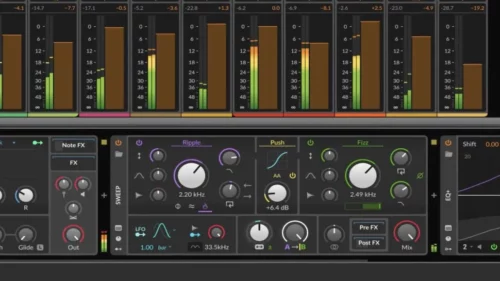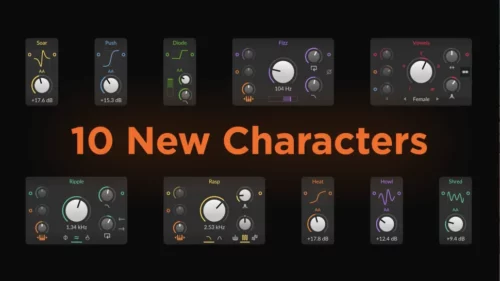Bitwig Studio 5.1 Now Available, Adds 10 New Modules
Bigwig has announced Bitwig Studio 5.1 is now available, an update that adds “10 new characters” – is this the most creative DAW ever
Bitwig Studio 5.1 introduces 10 new modules — four filters and six waveshapers — with 10 different sonic personalities. Some emulate classic structures, but most achieve their own, unique sonic qualities.
With version 5 of its DAW, Bitwig took the software up quite a few notches, turning what was already a fine music production suite into a creative monster. Version 5.1 sees that trend continue with more extras than you would normally expect from a single point update. Previously in beta, this is now fully released and available to anyone with a Bitwig Studio license and an active Upgrade Plan.
Version 5 of Bitwig Studio was a milestone release. But it does now mean you have to look at Studio with different eyes compared to other DAWs. It has become almost a creative instrument in itself, with modules taking centre stage and the whole modulation system meaning that pretty much anything can control anything else.
These, along with the already impressive Grid, itself a virtual environment in which you can create any instruments and effects, mean that Bitwig Studio is not your average DAW any more. And nor does Bitwig do average updates.

They can be loaded into the new audio FX containers Filter+ and Sweep or used as patch modules within The Grid. The filters — plus a brand-new oscillator — are also accessible as modules in the semi-modular synthesizer Polymer, which means they’re all accessible in every edition of Bitwig Studio. Additional voice stacking modulators have established a corresponding category, and important workflow improvements make audio editing faster and the mixer smarter.
Some of these additions can get confusing because the nature of Bitwig’s modular setup means that modules can go in different places – The Grid, per track, within containers, or even some (the four new filters and a new Bite oscillator) as modules in the Polymer semi-modular synthesizer.
Filter+, for example, enables you combine any of the now 14 Bitwig Studio waveshapers with one of a total of 10 filters and then add it to a track. Similarly, Sweep has a couple of slots for filters, a waveshaper and routing, and again enables you swap out whatever different modules.

Looking at the new filters and waveshapers in more detail, let’s start with Fizz, a phaser-like filter with vocal formant options. Rasp is brighter and more resonant; Ripple is a hyper-resonant filter which is great for acid like sounds; and finally there’s Vowels, a morphing formant type filter.
The six shapers include Push and Heat for softer and harder clipping; Soar is a wavefolder that increases loudness and can add a metallic edge; Howl adds a loud emphasis and a glitchy feel; Shred is hissy and zappy; and finally Diode is for warmer filter styles. The audio demos at the Bitwig website provide much better descriptors than our word-based attempts!
Other enhancements in 5.1 include additional voice stacking features to layer up to 16 voices per note from any polyphonic device and in several different ways. There are eight new modes for this in a new Stack Spread modulator. Additionally, you can tailor what the mixer shows to help speed up your workflow, and the audio engine has been improved for better quantisation.
New in Bitwig Studio 5.1:
- Sound Design Tools: Filters & Waveshapers – 5.1’s filters and waveshapers offer more options for coloring sounds. All are available both as Grid modules or housed within the new Filter+ and Sweep devices. A cast of three new Character filters bring distinct personalities that can make a simple waveform dynamic and fresh, and a new formant filter speaks for itself. The six shapers provide different flavors, with each changing at various intensities.
- Fizz can sparkle, shimmer like a phaser, or vocalize like a formant filter. Two cutoffs give control over the main filter and the filter inside the feedback circuit.
- Rasp adds brightness — and resonate nodes — around its cutoff frequency. Additional modes and controls mean the filter can go from nasal to throaty, or take a scream down to a whimper.
- Ripple is a hyper-resonant circuit allowing both playful feedback or elemental destruction, with three modes: Earth, Wind, and Fire. Tends to lock onto harmonics. Good for acid sounds — or acid rain.
- Vowels is a morphing formant filter with various models, pitch and frequency offsets.
- Push is a soft clipper with a detailed curve. Push it lightly for juice and harder to elicit harshness.
- Heat is an S-shaped clipper that starts soft but can drive hard, adding some sizzle at high levels.
- Soar is a soft wavefolder that makes the quietest parts loud. Can bring out subtleties or add a zippy, metallic edge.
- Howl puts different parts of the signal into the loud focus. A glitchy and snappy finish.
- Shred is a non-linear wavefolder for subtle cancellation or big-time artifacts. Hissy and zappy.
- Diode models the classic circuit with modern, zero-delay math. Internal bias and filter controls make it a warm, familiar option.
- Sweep and Filter+
- Filter+ and Sweep bring The Grid’s filters and waveshapers anywhere. These pre-patched audio FX combine modular slots, clear interfaces, and built-in modulators, bringing color and movement to any track. Each filter and shaper can be swapped out or bypassed to suit your needs, and right-clicking the device will convert your settings to a modifiable FX Grid patch.
- Filter+ lets you pair any of 14 waveshapers with one of the 10 filters. It’s ready for any track, channel, or nested chain and even has stereo modulation options.
- Sweep is an expressive, performance-ready filter bank with two filter slots, one waveshaper, and a routing knob for smoothly blending through several configurations.
- Voice Stacking Tools
- Bitwig Studio’s voice stacking feature allows any polyphonic device (and even compatible plug-ins) create multiple layers of sound. With 5.1, voice stacking is more powerful and easier to use.
- Up to 16 voices can now be layered for each note played, and there are more ways to shape these stacks. Eight new modes can be found in the Stack Spread modulator, putting harmonic, rhythmic, and even randomized relationships onto any parameter.
- Three new Grid modules make creating a spread mode easy and offer full mixer controls for each voice, anywhere you want it.
- Any voice can be soloed for easy sound programming. And since Sweep and Filter+ are based on FX Grid, that makes three audio FX that can use voice stacking and polyphony.
- Other Updates
- Mixer – A smarter, more flexible mixer allows you to customize Bitwig Studio’s GUI so you can reduce visual noise and focus on the task at hand. Drag the track faders and meters taller to see levels in detail, or shrink track widths down to a sliver to see more at once. With multiple tracks selected, adjusting the width, volume, panning of one track will adjust them all. The mixer update also offers a cleaner layout with scrollable sections for sends, better placement of comments at bottom, and redesigned track headers.
- Audio Quantize & Onset Threshold – Bitwig Studio 5.0 saw improved onset detector analysis of audio, and this new update brings improved audio functions. This starts with audio playback, now offering a threshold setting to control which transients affect stretching. This fine control is also built into various Slice functions (Slice In Place, Slice to Drum Machine and Slice to Multisample), and each visualizes its operation in a dialog and on the timeline display.
- A new Quantize Audio function is now available as well. From that dialog, you select the beat interval to match, which onsets to move, and the amount they should slide.
- Bite Oscillator – Bite is a special dual oscillator available now in The Grid and Polymer. By giving its two morphing oscillators good anti-aliasing and connecting them to each other with feedback, a wealth of analog techniques are unlocked. Crisper hard sync. Audio-rate pulse width modulation, and with some very custom shapes. And exponential FM can go from polite to wicked in no time. Finish it off with volume controls for each oscillator, one for ring modulation level, and some pleasant analog drift when settings change.
The latest Bitwig sound package contains 65 instrument presets and 18 audio FX. Some make use of the filters and waveshapers added to the Character category, the formant filter Vowels, or the edgy oscillator Bite, while others take advantage of Bitwig’s powerful voice stacking features.
Audio Demos:
Bitwig Studio 5.1 is available now. It’s a free upgrade for all Bitwig Studio license holders with an active Upgrade Plan.

























